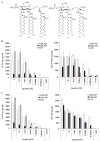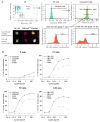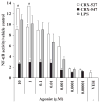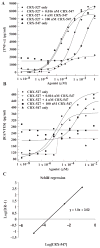Selective TRIF-dependent signaling by a synthetic toll-like receptor 4 agonist
- PMID: 22337809
- PMCID: PMC3684200
- DOI: 10.1126/scisignal.2001963
Selective TRIF-dependent signaling by a synthetic toll-like receptor 4 agonist
Abstract
In response to ligand binding to the Toll-like receptor 4 (TLR4) and myeloid differentiation-2 (MD-2) receptor complex, two major signaling pathways are activated that involve different adaptor proteins. One pathway depends on myeloid differentiation marker 88 (MyD88), which elicits proinflammatory responses, whereas the other depends on Toll-IL-1 receptor (TIR) domain-containing adaptor inducing interferon-β (TRIF), which elicits type I interferon production. Here, we showed that the TLR4 agonist and vaccine adjuvant CRX-547, a member of the aminoalkyl glucosaminide 4-phosphate (AGP) class of synthetic lipid A mimetics, displayed TRIF-selective signaling in human cells, which was dependent on a minor structural modification to the carboxyl bioisostere corresponding to the 1-phosphate group on most lipid A types. CRX-547 stimulated little or no activation of MyD88-dependent signaling molecules or cytokines, whereas its ability to activate the TRIF-dependent pathway was similar to that of a structurally related inflammatory AGP and of lipopolysaccharide from Salmonella minnesota. This TRIF-selective signaling response resulted in the production of substantially less of the proinflammatory mediators that are associated with MyD88 signaling, thereby potentially reducing toxicity and improving the therapeutic index of this synthetic TLR4 agonist and vaccine adjuvant.
Conflict of interest statement
Figures







Similar articles
-
Characterization of TRIF selectivity in the AGP class of lipid A mimetics: role of secondary lipid chains.Bioorg Med Chem Lett. 2015 Feb 1;25(3):547-53. doi: 10.1016/j.bmcl.2014.12.024. Epub 2014 Dec 17. Bioorg Med Chem Lett. 2015. PMID: 25553892 Free PMC article.
-
CD14 dependence of TLR4 endocytosis and TRIF signaling displays ligand specificity and is dissociable in endotoxin tolerance.Proc Natl Acad Sci U S A. 2015 Jul 7;112(27):8391-6. doi: 10.1073/pnas.1424980112. Epub 2015 Jun 23. Proc Natl Acad Sci U S A. 2015. PMID: 26106158 Free PMC article.
-
Type I interferon signaling contributes to the bias that Toll-like receptor 4 exhibits for signaling mediated by the adaptor protein TRIF.Sci Signal. 2014 Nov 11;7(351):ra108. doi: 10.1126/scisignal.2005442. Sci Signal. 2014. PMID: 25389373 Free PMC article.
-
TLR4 biased small molecule modulators.Pharmacol Ther. 2021 Dec;228:107918. doi: 10.1016/j.pharmthera.2021.107918. Epub 2021 Jun 23. Pharmacol Ther. 2021. PMID: 34171331 Review.
-
Immunopharmacology of lipid A mimetics.Adv Pharmacol. 2013;66:81-128. doi: 10.1016/B978-0-12-404717-4.00003-2. Adv Pharmacol. 2013. PMID: 23433456 Free PMC article. Review.
Cited by
-
TLR4-Targeting Therapeutics: Structural Basis and Computer-Aided Drug Discovery Approaches.Molecules. 2020 Jan 31;25(3):627. doi: 10.3390/molecules25030627. Molecules. 2020. PMID: 32023919 Free PMC article. Review.
-
Inefficient TLR4/MD-2 heterotetramerization by monophosphoryl lipid A.PLoS One. 2013 Apr 26;8(4):e62622. doi: 10.1371/journal.pone.0062622. Print 2013. PLoS One. 2013. PMID: 23638128 Free PMC article.
-
Intranasal vaccination promotes detrimental Th17-mediated immunity against influenza infection.PLoS Pathog. 2014 Jan;10(1):e1003875. doi: 10.1371/journal.ppat.1003875. Epub 2014 Jan 23. PLoS Pathog. 2014. PMID: 24465206 Free PMC article.
-
TRIF mobilizes unique primary defense against Gram-negative bacteria in intestinal interface.Gut Microbes. 2012 Sep-Oct;3(5):437-41. doi: 10.4161/gmic.20873. Epub 2012 Jun 20. Gut Microbes. 2012. PMID: 22713267 Free PMC article.
-
HIV-1 Tat Protein Activates both the MyD88 and TRIF Pathways To Induce Tumor Necrosis Factor Alpha and Interleukin-10 in Human Monocytes.J Virol. 2016 Jun 10;90(13):5886-5898. doi: 10.1128/JVI.00262-16. Print 2016 Jul 1. J Virol. 2016. PMID: 27053552 Free PMC article.
References
-
- Bortolatto J, Borducchi E, Rodriguez D, Keller AC, Faquim-Mauro E, Bortoluci KR, Mucida D, Gomes E, Christ A, Schnyder-Candrian S, Schnyder B, Ryffel B, Russo M. Toll-like receptor 4 agonists adsorbed to aluminium hydroxide adjuvant attenuate ovalbumin-specific allergic airway disease: Role of MyD88 adaptor molecule and interleukin-12/interferon-γ axis. Clin Exp Allergy. 2008;38:1668–1679. - PubMed
-
- Ishizaka ST, Hawkins LD. E6020: A synthetic Toll-like receptor 4 agonist as a vaccine adjuvant. Expert Rev Vaccines. 2007;6:773–784. - PubMed
-
- Johnson DA. Synthetic TLR4-active glycolipids as vaccine adjuvants and stand-alone immunotherapeutics. Curr Top Med Chem. 2008;8:64–79. - PubMed
Publication types
MeSH terms
Substances
Grants and funding
LinkOut - more resources
Full Text Sources
Other Literature Sources

